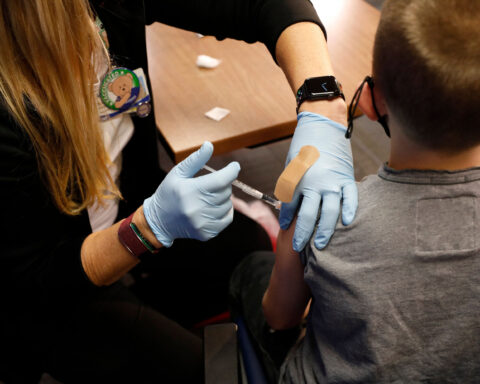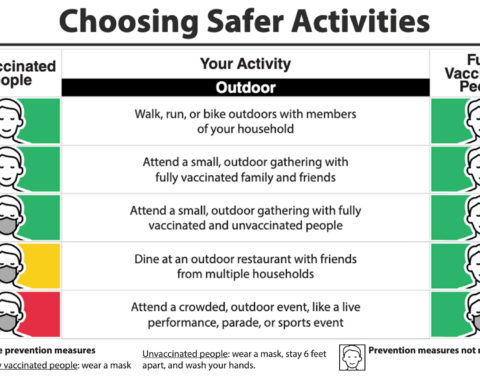The US may be on the cusp of another Covid-19 case surge, one expert says — a surge that health officials have repeatedly warned about as state leaders eased restrictions and several lifted mask mandates.
“I think we are going to see a surge in the number of infections,” emergency physician Dr. Leana Wen told CNN on Wednesday night. “I think what helps this time though is that the most vulnerable — particularly nursing home residents, people who are older — are now vaccinated. And so we may prevent a spike in hospitalizations and deaths.”
The first warning sign came when case numbers, after weeks of steep declines, appeared to level off — with the country still averaging tens of thousands of new cases daily. That kind of plateau previously predicted surges, some experts have said.
But governors cited fewer Covid-19 cases and more vaccinations while lifting measures aimed at curbing the spread of the virus.
Some local leaders also eased restrictions: Chicago officials earlier this month raised indoor capacity for bars, restaurants and other businesses and Baltimore leaders announced Wednesday they were easing restrictions on places including religious facilities, retail stores and malls, fitness centers and food service establishments — changes that will go into effect next week.
All that while cases of the worrying variants — notably the highly contagious B.1.1.7 variant — climbed. The variants have the potential to wipe out all the progress the US made if Americans get lax with safety measures, Centers for Disease Control and Prevention Director Dr. Rochelle Walensky warned recently. The B.1.1.7 variant, she said this week, is projected to become the dominant variant in the US by the end of this month or early April.
Despite the warnings, spring break crowds are gathering — with Florida officials reporting too many people and not enough masks — and nationwide, air travel numbers are hitting pandemic-era records.
Now, as the country inches closer to 30 million reported infections, cases are rising by more than 10% in 14 states this week compared to last week, according to Johns Hopkins University data — with half of those states seeing a rise of more than 20%.
“We are really in a race here,” Dr. Richard Besser, the former acting CDC director, told CNN on Wednesday. “We’re in a race to get the population vaccinated. At the same time, we’re fighting people’s exhaustion with the restrictions that public health has put in place and we’re fighting the move by so many governors to remove the restrictions that are keeping us all safe.”
“These factors are really concerning,” he added.
What’s causing some local spikes
Michigan cases are increasing the fastest, with more than a 50% jump this week compared to last, according to the Johns Hopkins data. Delaware, Montana, Alabama and West Virginia have also seen big increases.
There’s a long list of factors contributing to the spike in cases in Michigan, according to Dr. Jennifer Morse, the medical director for the Mid-Michigan District Health Department.
Those include the rolling back of restrictions, a prison outbreak, Covid-19 fatigue, a failure to wear masks, and the B.1.1.7 variant fueling the surge, Morse told CNN. Michigan Gov. Gretchen Whitmer eased restrictions earlier this month, upping capacity limits at restaurants as well as in retail stores, gyms and other facilities.
“My one hope is that we have been really aggressively vaccinating and have been working through the different categories for vaccination quite well,” Morse told CNN. “And my hope is that that will help to keep (cases) from climbing as rampantly as (they) did back in the fall.”
In West Virginia, Gov. Jim Justice said Wednesday that Covid-19 hospitalizations have “jumped up” slightly in the state, asking residents to continue their mitigation efforts “a little while longer.”
“We have 70 people in the ICU, that’s up a little bit,” Justice said.
Justice had eased restrictions earlier this month, increasing capacity at bars, restaurants and other businesses to 100% and upping the social-gathering limit.
During Wednesday’s news briefing, he added that the state has had “seven outbreaks in our church community” across five counties.
Church gatherings “can really cause an issue, because we’re singing…probably embracing,” the governor said. “If you decided to go to church, please keep that pew in between you and wear your mask.”
You asked, we answered: Your top questions about Covid-19 and vaccines
More testing will help stop spread, CDC says
Even as vaccination numbers grow, what could play a key role in helping control the pandemic will be more accessible, inexpensive coronavirus tests, top health officials said Wednesday, speaking at a hearing of the House Energy and Commerce Committee.
“You are going to be seeing more of that soon,” said Dr. Anthony Fauci, the director of the National Institute of Allergy and Infectious Diseases.
Walensky, the CDC director, added, “I do believe that once we have teachers vaccinated that we can use testing in the schools — serial testing, cadence testing — to identify potential infections, asymptomatic infections, shut down clusters and keep our schools open.”
Her remarks came the same day the CDC released updated guidance about testing, saying more and better testing should help catch asymptomatic cases and control the spread.
The overview guidance, Walensky told a White House briefing, describes available tests used to detect the virus, how to choose a test, the reasons for using them, and the impacts of vaccinations on testing.
“Importantly, until now, limited test capacity has resulted in our use of tests for largely diagnostic purposes, when someone presents with symptoms or has been exposed,” Walensky said. “Only in selected places have we capitalized on the benefits of how testing can be used as a screening intervention with frequent tests to identify asymptomatic disease and prevent clusters before they start.”
Nearly 1 in 8 Americans fully vaccinated
Meanwhile, vaccinations have accelerated as officials race to get as many shots into arms as quickly as possible.
More than 73.6 million Americans have received at least one dose of a Covid-19 vaccine, according to CDC data. And more than 39.9 million people are fully vaccinated — roughly 12% of the US population.
Check your state’s Covid-19 vaccine eligibility requirements here
But challenges — including vaccine hesitancy, disinformation and inequities — remain, and it’s not entirely clear when the US will hit herd immunity — the point at which enough people are protected against the virus to suppress spread.
On Wednesday, both Fauci and Walensky pushed back against questions about herd immunity, saying a lot depended on how quickly Americans take vaccines.
“Let’s just keep pushing to get as many people vaccinated as we possibly can,” Fauci said. “And as we do that, you will see the type of infection, the dynamics of the outbreak, get less and less and less, so whatever that time is — middle of the summer, end of the summer, early fall, we’ll be much, much better off than we are now.”
For now, the US still has a long way to go to overcome vaccine hesitancy, said National Institutes of Health Director Dr. Francis Collins.
Vaccination is the country’s best hope to get beyond the pandemic, he said, “and yet there’s all this overlay, and some of it is politics and some of it’s social media conspiracy theories and some of it is just distrust of anything that the government had anything to do with.”
“We have a long way to go yet to try to overcome that,” he told CNN on Wednesday.
Track Covid-19 vaccinations here
Achieving vaccine equity is important, CDC says
Additionally, in the first two and half months of vaccine distribution, counties considered to have high social vulnerability had lower vaccine coverage than counties considered to have low social vulnerability, according to a study published Wednesday by the CDC.
The agency’s social vulnerability index identifies communities that may need additional support during emergencies based on more than a dozen indicators across four categories: socioeconomic status, household composition, racial/ethnic minority status and housing type.
By March 1, vaccination coverage was about 2 percentage points higher in counties with low social vulnerability than in counties with high social vulnerability — and the differences were largely driven by socioeconomic disparities, particularly differences in the share of the population with a high school diploma and per capita income.
Only five states — Arizona, Montana, Alaska, Minnesota and West Virginia — had higher coverage in counties with high social vulnerability. And best practices in those states included prioritizing racial/ethnic minority groups in early vaccine coverage, actively monitoring barriers to vaccination, directing vaccines to vulnerable communities, offering free transportation to vaccination sites and working with community partners, the study said.
Achieving vaccine equity, the CDC said, is an important goal requiring “preferential access and administration to those who have been most affected” beyond proportionate distribution based on population.





